This page contains links through which we may earn a small commission should you decide to book a tour from our partner.
Top attractions:
About Josefstadt
Josefstadt, Vienna’s smallest district, sits quietly between the grand avenues of the Inner City and the residential calm of Hernals. Despite its modest size—barely one square kilometer—it’s one of the capital’s most desirable areas to live in, prized for its elegant architecture, excellent transport links, and local character. The district is very well-connected; its narrow streets are filled with cafés, bakeries, and small theaters that keep the local rhythm alive, while landmarks like the Theater in der Josefstadt, one of the oldest continuously operating playhouses in the German-speaking world, add a sense of tradition and refinement.
Founded in 1850 and named after Emperor Joseph I, Josefstadt grew during the Biedermeier period when Vienna began to expand beyond its medieval walls. Many of its pastel-colored townhouses date back to that era, giving the district its distinct bourgeois charm. Walking through Strozzigasse or Lerchenfelder Straße, you can still sense the balance between history and daily life—where 19th-century façades hide cozy modern apartments, and ornate doorways lead to lush inner courtyards. Its proximity to the University of Vienna also makes the district a popular choice for academics and students, who fill its cafés with quiet chatter and open books.
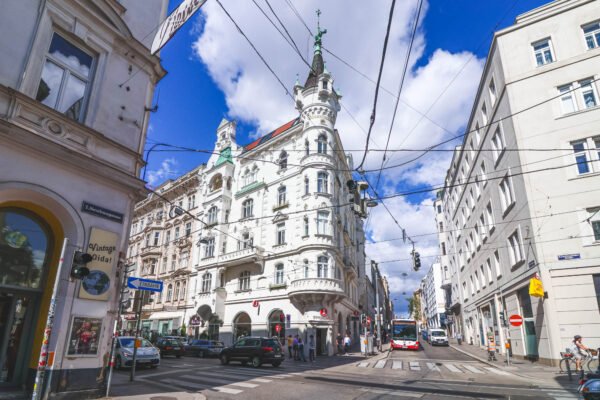
Lerchenfelder Str. 26, 1080 Wien. Photo by Alis Monte [CC BY-SA 4.0], via Connecting the Dots
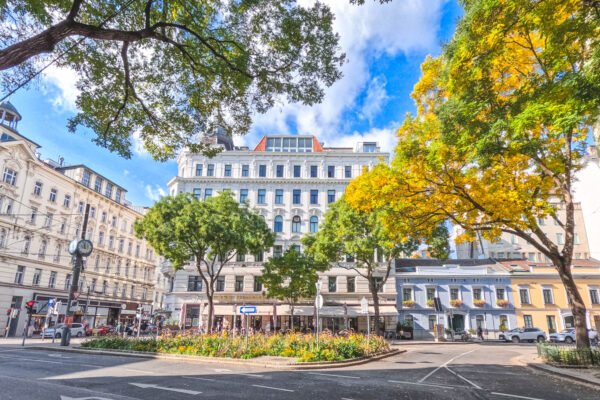
Josef Matthias Hauer Platz. Photo by Alis Monte [CC BY-SA 4.0], via Connecting the Dots
Beyond its architecture, Josefstadt is a microcosm of Viennese living: cultured yet unpretentious, historic yet forward-looking. Locals gather at places like Café Hummel or the Brunnenpassage for art, discussion, and music, while the district’s markets and small shops maintain a village-like atmosphere in the middle of the city. Despite being only minutes away from the Ringstraße, Josefstadt retains a sense of community rare in the center of a European capital—a neighborhood where history isn’t just admired but lived in, day after day.
Josefstadt Details
- Number: 8th District of Vienna
- Coordinates: 48.2100° N, 16.3477° E
- Distance from Rathaus: Adjacent to Vienna City Hall (Rathaus); an easy short walk
- First mentioned: 1700 (Wien Geschichte Wiki, source)
- Population: ~24,200 (2025 est.)
- Area size: 1.08 km² / 0.42 sq mi
- Elevation: 192 m / 630 ft
- District Museum: Schmidgasse 18, 1080 Wien, Austria
- Public transport connections: U2, U6, 2, 5, 12, 43, 44, bus 13A
Josefstadt Location
Josefstadt is surrounded by the Ottakring (16th) and Hernals (17th) to the west, Alsergrund (9th) to the north, the Inner Stadt (The Old Town) to the east, and Neubau (7th) to the South.
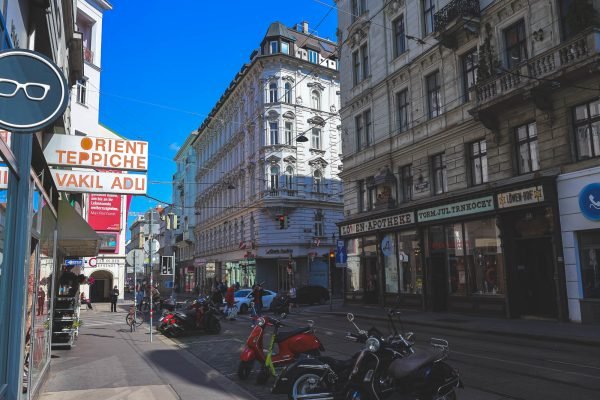
Josefstadt, Vienna: A charming district blending the historic and the contemporary, embodying Vienna’s vibrant culture and elegant lifestyle. Photo by Alis Monte [CC BY-SA 4.0], via Connecting the Dots
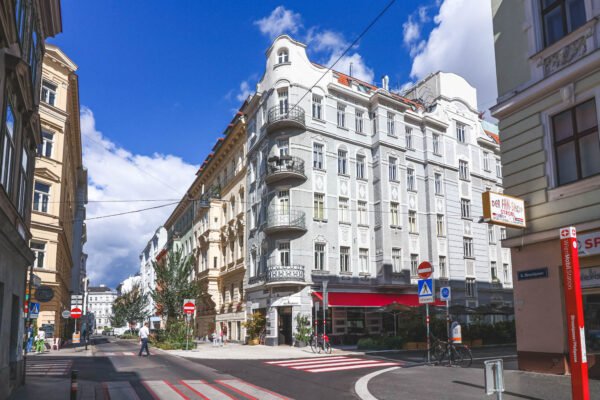
Strozzigasse 24, 1080 Wien. Photo by Alis Monte [CC BY-SA 4.0], via Connecting the Dots
Historical Overview of Josefstadt
Josefstadt’s origins can be traced back to the Middle Ages, when it was mostly comprised of vineyards and open fields. By the 18th century, the area started to become more urbanized with the establishment of the Piarist Order in 1697/98 and the construction of the Piaristenkirche and the adjoining school. This marked the district’s transformation into a residential and academic hub.
In the 19th century, Josefstadt experienced a period of significant growth, with the founding of the Theater in der Josefstadt in 1788, today considered Vienna’s oldest continuously operating theatre. The district was officially recognized as part of Vienna in 1850, when the city expanded to incorporate surrounding suburbs.
Throughout the 20th century, Josefstadt maintained its academic and intellectual character. Despite the destructive forces of World War II, the district managed to preserve most of its historical architecture, resulting in a neighborhood that feels like a journey back in time.
Timeline of Important Historical Events in the District
- 1698: The Piarist Order establishes a presence in the district.
- 1784: Emperor Joseph II founded the General Hospital of Vienna (AKH) in neighboring Alsergrund (9th district), which influenced the area’s academic character.
- 1788: The Theater in der Josefstadt is founded.
- 1850: Josefstadt is officially incorporated into Vienna.
Today, in my humble opinion, Josefstadt is the most ‘Viennese’ district.
Name Origins of the District
Josefstadt literally translates to “Joseph’s Town,” named after Emperor Joseph I. The name appears in city records from 1700 and reflects the period’s Habsburg influence on the area’s development.
Notable Landmarks and Historical Sites in Josefstadt
While the main attraction of Josefstadt is Josefstadt itself, it doesn’t mean there is nothing specific to see. The obvious suspect is Piaristenkirche, but there is more. If you decide to explore this classical Viennese district by foot, be sure to visit some of these historical sites.
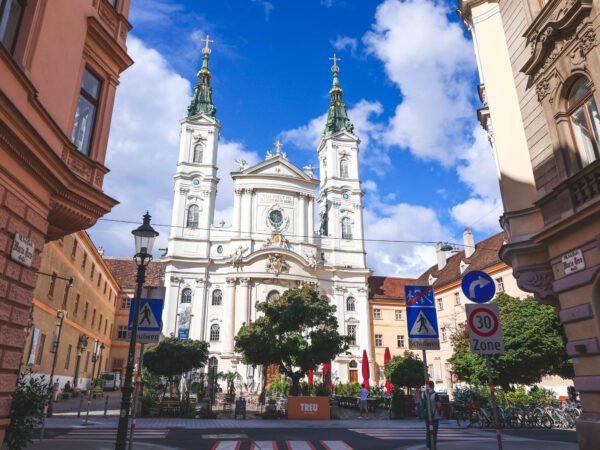
Piaristenkirche in Vienna: A testament to baroque architecture, where history intertwines with spirituality in the heart of Austria’s capital. Photo by Alis Monte [CC BY-SA 4.0], via Connecting the Dots
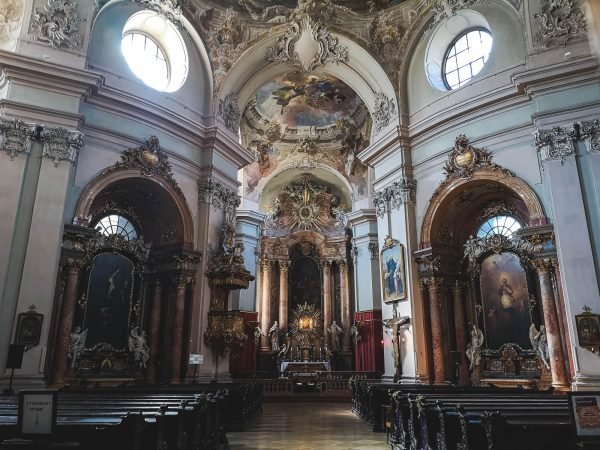
The inside of Piaristenkirche is just as beautiful as the outside. Photo by Alis Monte [CC BY-SA 4.0], via Connecting the Dots
Piaristenkirche
A Baroque landmark of the Piarist Order, the Piaristenkirche (Maria Treu) anchors the surrounding square. The Piarists have been present here since 1697/98; the church and adjoining school were completed in the 18th century. Every element of its design, from the awe-inspiring frescoes that grace its walls to the meticulously crafted sculptures that dot its interior, showcases the zenith of artistic expression of that era. As one steps inside, the church embraces its visitors with an enveloping sense of tranquility, providing a stark, peaceful contrast to the ever-busy streets of Vienna outside its doors.
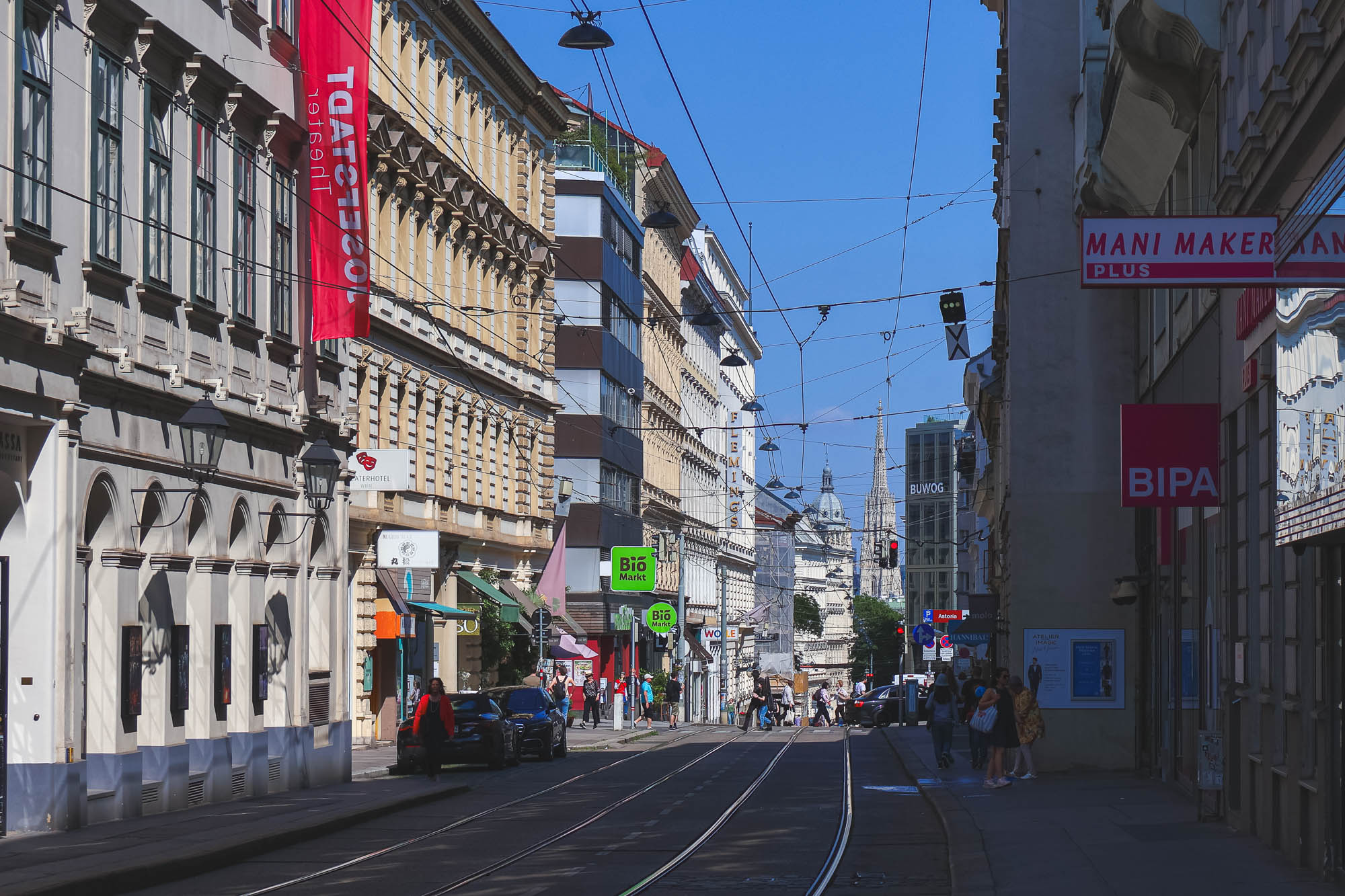
Stephansdom seen from Josefstädter Straße (Theater in der Josefstadt on the left). Photo by Alis Monte [CC BY-SA 4.0], via Connecting the Dots
Theater in der Josefstadt
Founded in 1788, this iconic house is Vienna’s oldest continuously operating theatre. Over the centuries, it has hosted plays by celebrated Austrian writers and has seen performances by legendary actors. Its lavish architecture and rich history make it a beacon for theatre enthusiasts worldwide, as it continues to showcase high-quality productions.
Palais Strozzi
A palatial mansion built in the 18th century for the Strozzi family, it’s now used as a venue for exhibitions and events. Its ornate façade and elegant courtyard are worth admiring.
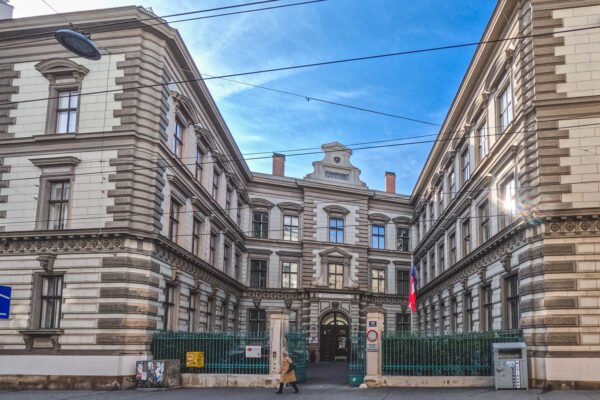
Palais Strozzi. Photo by Alis Monte [CC BY-SA 4.0], via Connecting the Dots
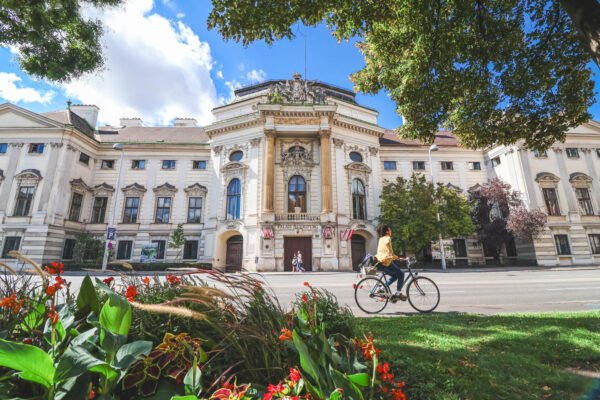
Palais Auersperg is located just minutes of walk from Rathaus Wien. Photo by Alis Monte [CC BY-SA 4.0], via Connecting the Dots
Palais Auersperg
Located on the edge of the inner city, Palais Auersperg stands as another radiant testament to the city’s Baroque architectural heritage. Constructed in the early 18th century, this grand palace has witnessed numerous historical events and has played host to eminent personalities, including Mozart who performed in its lavish ballroom. Today, its opulent rooms and sprawling gardens are a popular venue for cultural events, concerts, and galas, allowing visitors to step back in time and relive the grandeur of Vienna’s golden age.

Breitenfelder Kirche is situated by the belt ring, locally known as ‘gurtel’. Photo by Alis Monte [CC BY-SA 4.0], via Connecting the Dots
Breitenfelder Kirche
Also dedicated to Saint Francis of Assisi, the Breitenfelder Pfarrkirche is a late‑19th‑century brick church in the Lombard early‑Renaissance / neo‑Romanesque tradition. Its façade and interior detailing make it a distinct landmark on the Gürtel side of the district. The best way to appreciate it is through the window of the subway U6.
Things to Do in Josefstadt
In addition to exploring its historical sites, Josefstadt offers a range of activities that highlight its cultural and artistic charm. Here are some suggestions:
Visit a Theatre Show
Grab the chance to watch a performance at the Theater in der Josefstadt or the Theater Drachengasse in the inner city. The variety of productions, from classical to contemporary, will surely delight theatre enthusiasts. Josefstadt is home to Vienna’s English Theatre – the only English-first theater in the city.
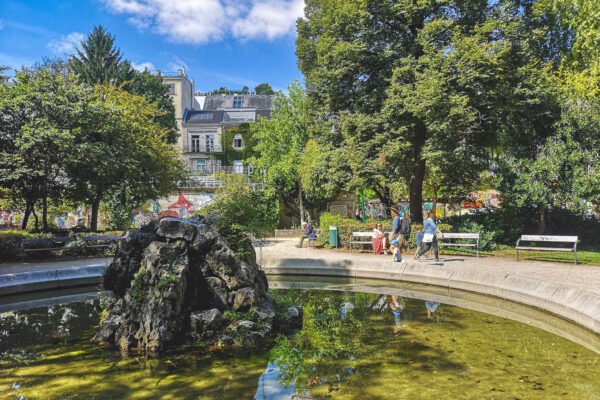
Schönborn Park. Photo by Alis Monte [CC BY-SA 4.0], via Connecting the Dots
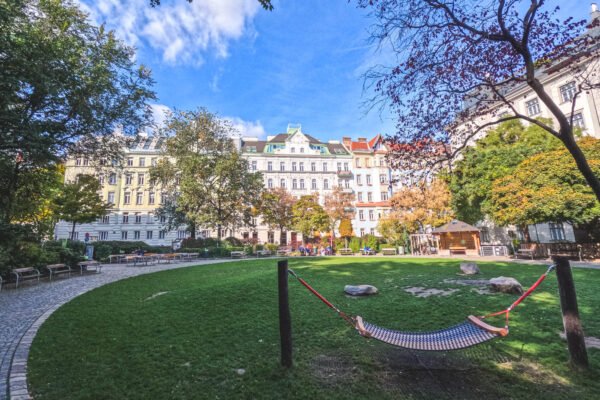
Hammerlingpark. Photo by Alis Monte [CC BY-SA 4.0], via Connecting the Dots
Relax in one of the Green Areas
Due to its size, Josefstadt is not known for its green areas, but whatever it is, the Schönborn Park or Hammerlingpark, it feels surprisingly secluded, given its exquisitely central location. They offer various activities for all age groups, though I would say Hammerlingpark is better for relaxation and Schönborn Park for sports. Both are equally good for children, except that Hammerlingpark has dedicated areas to toddlers.
Visit Josefstadt’s Museum
The museum offers visitors a comprehensive glimpse into the area’s past, from its early establishment to its modern evolution. Exhibits showcase everything from historic artifacts to personal narratives of the district’s residents. Whether you’re a history enthusiast or just curious about local lore, Josefstadt’s museum promises an enlightening and memorable experience.
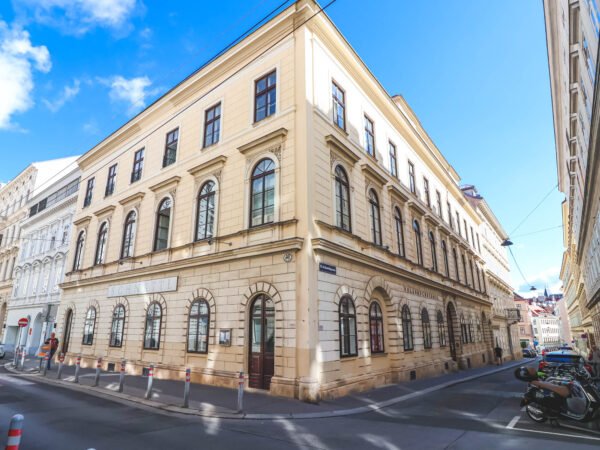
Josefdtadt’s district museum. Photo by Alis Monte [CC BY-SA 4.0], via Connecting the Dots
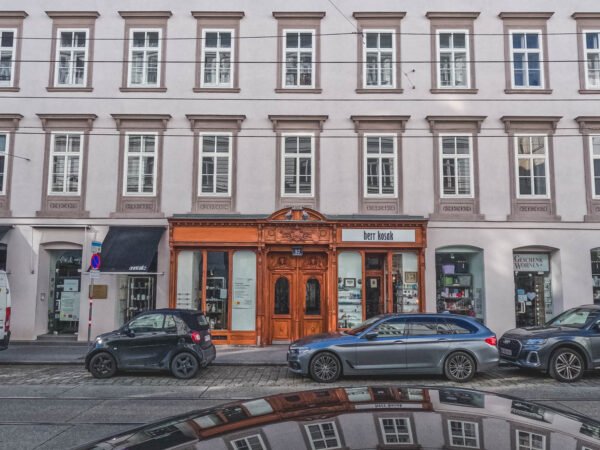
Base floor of Josefstadt is full of charming boutique businesses. Photo by Alis Monte [CC BY-SA 4.0], via Connecting the Dots
Shop at Local Boutiques on Josefstädter Straße
As the main street of the district, Josefstädter Straße offers a mix of high-end boutiques, quirky shops, and artisan stalls. Whether you’re looking for souvenirs, fashion, unique crafts, local wines, or simply a good coffee, this vibrant street has it all.
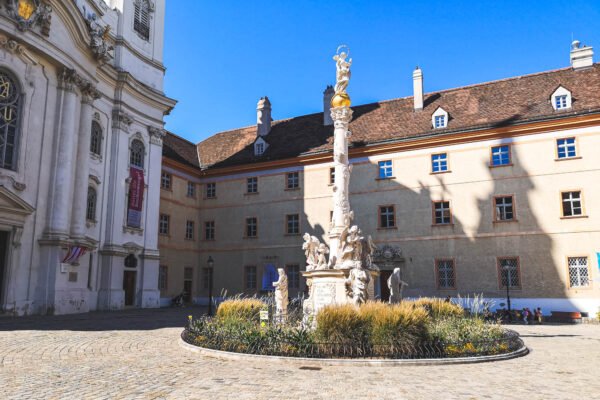
Marientreusäule is a historic column dedicated to the Virgin Mary, symbolizing gratitude and devotion. Photo by Alis Monte [CC BY-SA 4.0], via Connecting the Dots
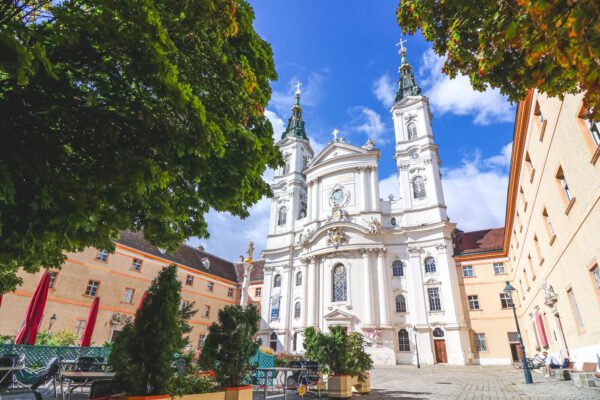
Piaristenkirche. Photo by Alis Monte [CC BY-SA 4.0], via Connecting the Dots
Enjoy a drink at Jodok Fink Square
This small square features a fountain and a monument in the middle of it, but most importantly, Jodok Fin Square is surrounded by historic buildings, including the beautiful Piaristenkirche, cafes, and restaurants, making it a perfect spot for a stop.
Wander around Josefstadt’s Courtyards
Tucked behind the district’s main façades, many of Josefstadt’s courtyards are serene little oases in the midst of the urban sprawl. These hidden gems offer a quiet escape and showcase a blend of architectural styles, lush gardens, and local art installations. It’s a perfect way to discover the district’s less-frequented beauty.
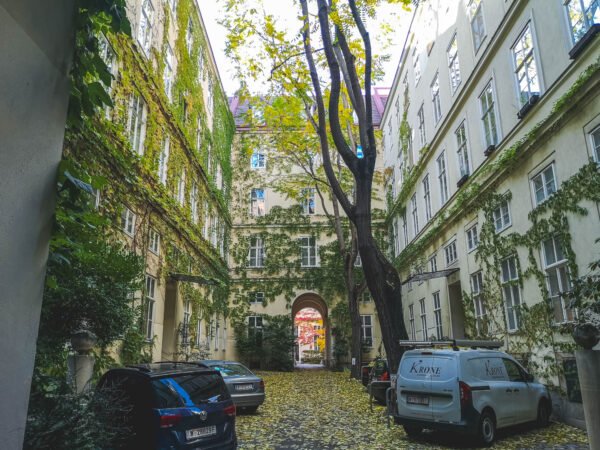
A random inneryard in Josefstadt. Photo by Alis Monte [CC BY-SA 4.0], via Connecting the Dots
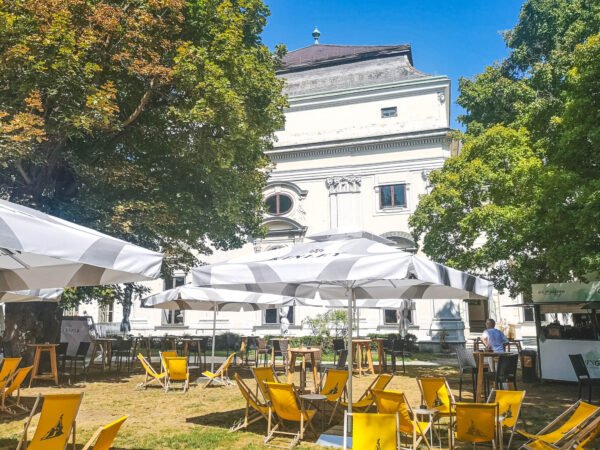
Palace Auersparg inneryard summer stage. Photo by Alis Monte [CC BY-SA 4.0], via Connecting the Dots
Places to Eat and Drink in Josefstadt
The district’s food-and-drink scene punches above its size. For coffee and a slow breakfast, Café Eiles and Café Hummel are the archetypal Viennese coffeehouses—newspapers, pastries, generous breakfasts, and that unhurried old‑Vienna rhythm. Tucked by Piaristenplatz, bohemian Café der Provinz does Breton‑style galettes, crêpes, and waffles—perfect for brunch or a sweet pause.
For something heartier, locals swear by Il Sestante next to the same Piaristenkirche for wood‑fired, Neapolitan‑style pizzas and easygoing Italian plates. When the craving is classic Viennese, Fromme Helene serves reliable staples—Wiener Schnitzel, Tafelspitz, and seasonal specials—in a warm, old‑school dining room. This typical Viennese restaurant is the usual place where I bring visiting friends when they ask for a typical local cuisine. Accidentally, when I first came to live in Vienna, I stopped by Fromme Helene for my first ever meal in the city.
Nights out in Josefstadt are compact and fun. Sip Austrian pours in ivy‑lined Weinstube Josefstadt, catch open mics and small gigs at Tunnel Vienna Live, go loud under the U6 arcades at Café Carina, or end with polished classics at Grande Cocktail Bar. Everything’s walkable; string two or three stops together and you’ve got a perfect Josefstadt evening.
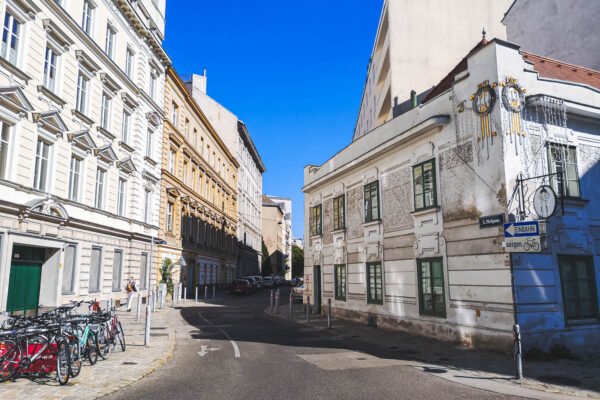
A random secession building in Pfeilgasse. Photo by Alis Monte [CC BY-SA 4.0], via Connecting the Dots
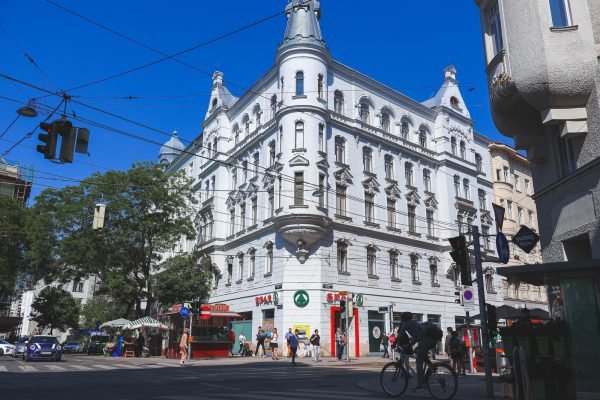
Josefstadt is the 8th district of Vienna. Photo by Alis Monte [CC BY-SA 4.0], via Connecting the Dots
Accommodation in Josefstadt
Small but central, Josefstadt packs plenty of good stays within a few quiet blocks of the Ring. For boutique character and a wine‑lover twist, Hotel Rathaus – Wein & Design dedicates each room to an Austrian winemaker and sits a short stroll from Rathaus. Next to the Theater in der Josefstadt, Cordial Theaterhotel Wien leans classic and comfortable with easy tram links. On a tighter budget, Pension Excellence offers simple, clean rooms in a traditional Viennese building.
Prefer a home base? Short‑stay apartments and guesthouses dot the side streets around Piaristenplatz and Josefstädter Straße; you’ll be minutes from cafés, theatres, and U‑Bahn/U‑Bim connections, making Josefstadt a convenient, calm launchpad for the inner city.
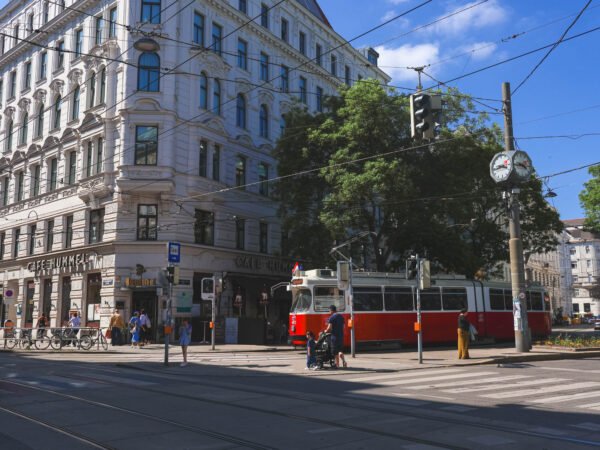
Centrally located, Josefstadt is easy to access from every direction. Photo by Alis Monte [CC BY-SA 4.0], via Connecting the Dots
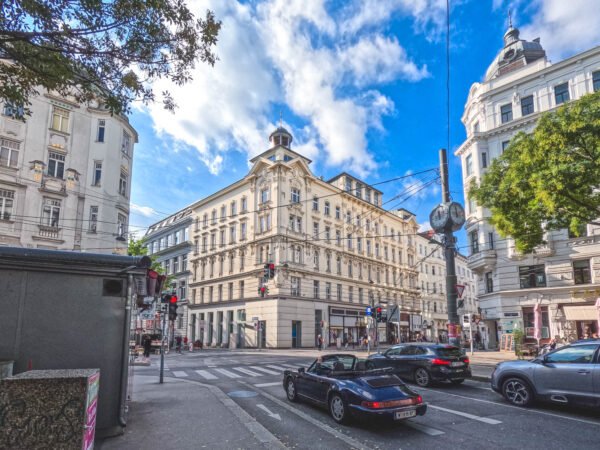
Josef Matthias Hauer Platz. Photo by Alis Monte [CC BY-SA 4.0], via Connecting the Dots
Getting to & around Josefstadt
Josefstadt, a charming district in Vienna, boasts an easily accessible location. The compact nature of the district, combined with Vienna’s excellent transportation, means you can explore Josefstadt and the broader city with ease:
By Tram
Tram lines 2, 5, 12, 43, and 44 traverse Josefstadt, providing seamless connections to neighboring districts and the inner city. They present a scenic and relaxed mode to experience the district’s ambiance and beauty.
By U-Bahn (Subway)
The U6 line (Josefstädter Straße) serves the district, and the U2 stops at Rathaus/Volkstheater on the district’s edge, linking quickly to the city center.
By Bus
Key bus connections include the frequent 13A (plus select local lines).
By Bicycle
Josefstadt encourages eco‑friendly travel, and with WienMobil Rad (Vienna’s city bike‑share), residents and visitors can navigate the district’s picturesque lanes on two wheels. There are numerous cycle paths, ensuring a safe and pleasant ride.
By Car
Though Josefstadt is well-serviced by public transport, if you prefer driving, car rentals are available. Be mindful of the short-term parking zones in place from Monday to Friday, between 9 a.m. and 7 p.m. in Vienna.
Journeying through Josefstadt is a pleasure, whether you’re a local or a visitor. Its central location ensures easy access to Vienna’s attractions, but don’t forget to set aside time to explore Josefstadt’s own historical landmarks and quaint avenues.
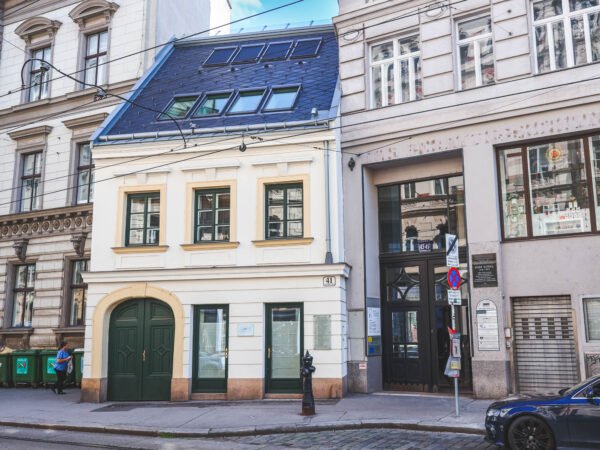
Josefstadt might lack monumental buildings that other district have, but it has a charm of its own a small town within the city. Photo by Alis Monte [CC BY-SA 4.0], via Connecting the Dots
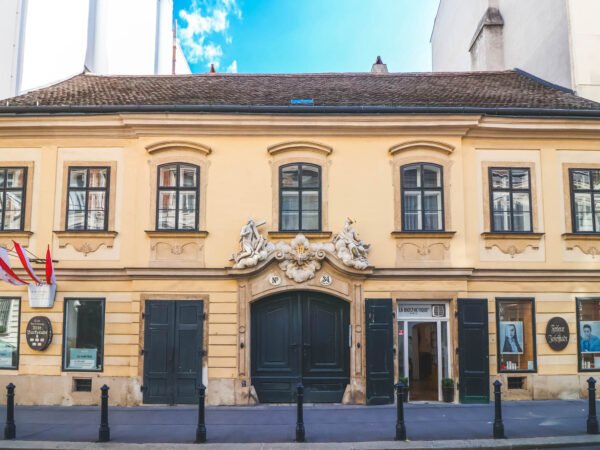
Baroque House at Langegasse. 34, 1080 Wien. Photo by Alis Monte [CC BY-SA 4.0], via Connecting the Dots
Personal Favourites
No matter how many times I return, Josefstadt holds a special place for me in Vienna, with its most iconic location – Jodok Fink Platz with Piaristenkirche. I find myself inviting people there for a dinner or a coffee again an again. Even outside this iconic square, lies many Viennese places I keep recommending. Though at the moment, my new favourite area of the 8th district is the area around Josef Matthias Hauer Platz. It is beautiful like the rest of Jesefstadt, just more so. Overall, this small district feels like a self-contained peaceful Art Nouveau town wrapped up in action and culture from all sides.
I never lived in Josefstadt myself but always within a close proximity, making the 8th district of Vienna one of my most visited and favourite districts. I won’t hide, I wouldn’t mind finding Josefstadt my next home. Some parts of it are top locations to live in Vienna. Take area next to Rathaus for example. Overall, it is a very livable district: the area close to Alsergrund (9th district) is explicitly peaceful, while Lerchenfeldergasse keeps up in trendiness with the king hipster Neubau (7th district).
Except for its vivid and authentic Viennese architecture and local vibes, Josefstadt’s location is the top argument for it being the prime district of Vienna. Practically, this is a district built for simple logistics: U2 and U6 sit on the edges (with U5 under construction), trams 2, 5, 12, 43, and 44 criss‑cross the core, and most sights are ten minutes apart on foot. Josefstadt, most likely, won’t suit hard‑charging nightlife hunters, but if you value short walks, reliable transport, and a lived‑in neighborhood rhythm with similar faces, you’ll appreciate how quickly it becomes your comfortable base in Vienna.
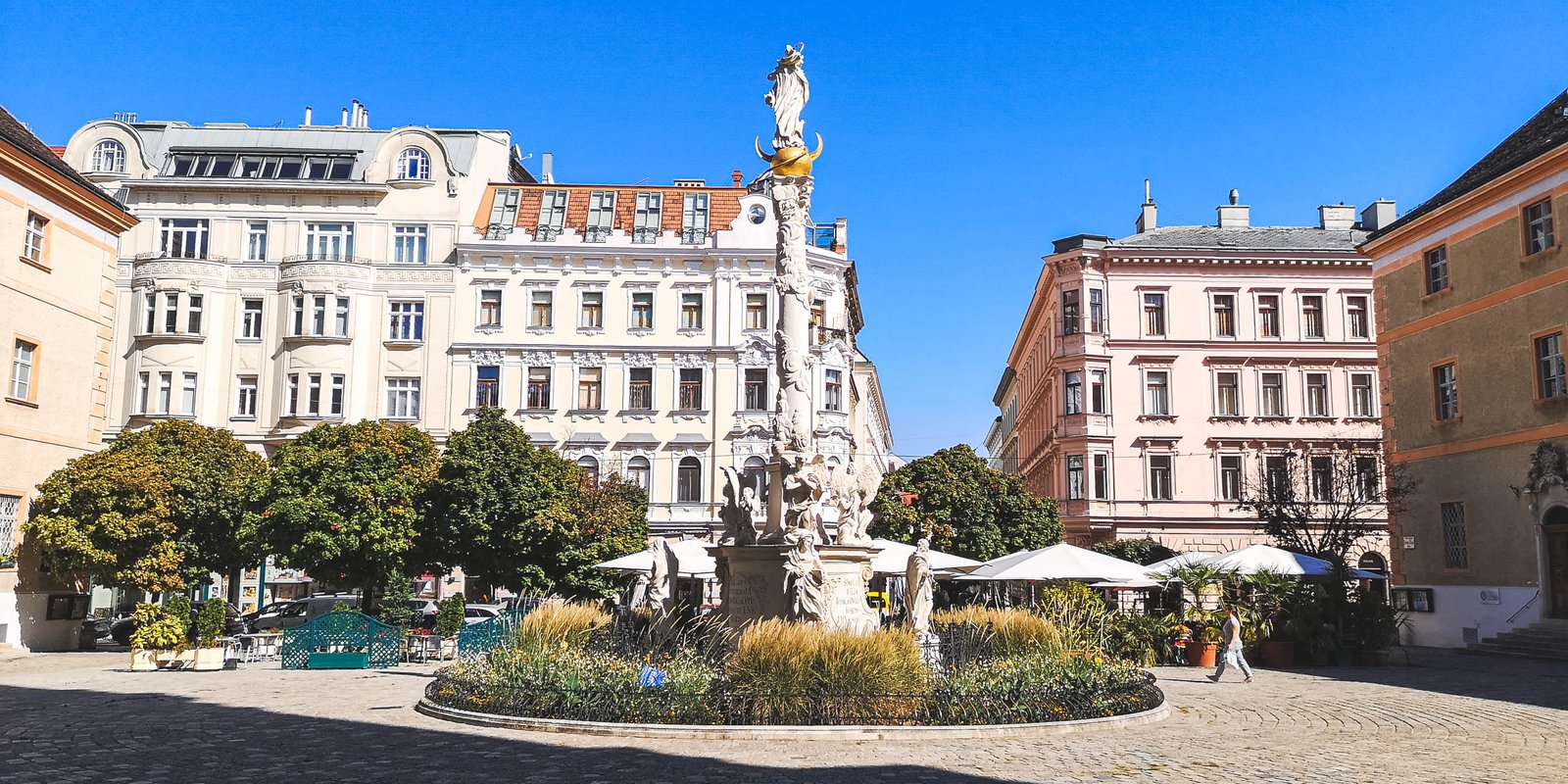
All content and photos by Alis Monte, unless stated differently. If you want to collaborate, contact me on info@ctdots.eu Photo by Alis Monte [CC BY-SA 4.0], via Connecting the Dots
Frequently Asked Questions
What is Josefstadt known for?
Josefstadt is known for being Vienna's smallest district with the highest quality of life, featuring historic baroque architecture, the Theater in der Josefstadt, Piaristenkirche, and a vibrant café culture.
Where is Josefstadt located in Vienna?
Josefstadt is the 8th district of Vienna, set between the Zweierlinie and the Gürtel just northwest of the 1st district; it borders Vienna City Hall (Rathaus).
How do I get to Josefstadt?
Take U‑Bahn U6 to Josefstädter Straße or U2 to Rathaus/Volkstheater. Trams 2, 5, 12, 43, and 44 and bus 13A also serve the district.
What are the main attractions in Josefstadt?
Main attractions include Piaristenkirche (Maria Treu Church), Theater in der Josefstadt, Palais Auersperg, Palais Strozzi, and Breitenfelder Kirche, plus charming Josefstädter Straße for shopping and dining.
Is Josefstadt a good area to stay in Vienna?
Yes—Josefstadt offers central location, excellent public transport, quality accommodations like Hotel Rathaus Wein & Design, and a peaceful village-like atmosphere within the city center.
What is the best way to explore Josefstadt?
Walk through the district's narrow streets to discover hidden courtyards, baroque buildings, and cozy cafes; the compact size (1.08 km²) makes it perfect for exploring on foot.
When was Josefstadt established?
First mentioned in 1700 and officially incorporated into Vienna in 1850; named after Emperor Joseph I.